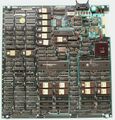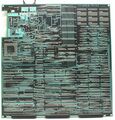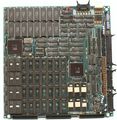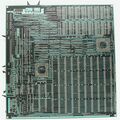Difference between revisions of "Sega OutRun hardware"
From Sega Retro
| Line 23: | Line 23: | ||
{{multicol| | {{multicol| | ||
* Sound CPU: [[Zilog]] [[Zilog Z80|Z80]] @ 4 MHz (8/16‑bit instructions, 0.58 MIPS) | * Sound CPU: [[Zilog]] [[Zilog Z80|Z80]] @ 4 MHz (8/16‑bit instructions, 0.58 MIPS) | ||
| − | * Sound chips: 2 chips, 24 channels | + | * Sound chips: 2 chips, 24 channels {{ref|1=http://arcarc.xmission.com/PDF_Arcade_Manuals_and_Schematics/Outrun%20Schematics.pdf#page=8}} |
| − | ** [[wikipedia:Frequency modulation synthesis|FM synthesis]] chip: [[Yamaha YM2151]] @ 4 MHz (8 FM channels) | + | ** [[wikipedia:Frequency modulation synthesis|FM synthesis]] chip: [[Yamaha YM2151]] @ 4 MHz (8 FM channels, 8‑bit bus width) {{ref|http://map.grauw.nl/resources/sound/yamaha_ym2151_datasheet.pdf}} |
| − | ** [[Pulse-code modulation|PCM]] sampling chip: SegaPCM | + | ** [[Pulse-code modulation|PCM]] sampling chip: SegaPCM 315‑5218 Sound Controller @ 4 MHz {{ref|[https://github.com/mamedev/mame/blob/master/src/mame/drivers/segaorun.cpp Sega OutRun Hardware (MAME)]}} ([[wikipedia:Stereophonic sound|stereo]] output, 16 PCM channels, [[wikipedia:Audio bit depth|12‑bit audio depth]],{{ref|[http://cgfm2.emuviews.com/txt/loftech.txt Sega X Board Hardware Notes (12/03/2004)]}} 31.25 kHz [[wikipedia:Sampling rate|sampling rate]], 16‑bit bus width) |
}} | }} | ||
| Line 36: | Line 36: | ||
** 315‑5228 Signetics CK2605 FPGA: 8‑bit {{fileref|303A-011A Device List.pdf|page=11}}{{fileref|CK2605 Fusemap.pdf}} | ** 315‑5228 Signetics CK2605 FPGA: 8‑bit {{fileref|303A-011A Device List.pdf|page=11}}{{fileref|CK2605 Fusemap.pdf}} | ||
** 315‑5242 Sega Custom Color Encoder: 16‑bit | ** 315‑5242 Sega Custom Color Encoder: 16‑bit | ||
| − | * Main Board GPU: Sega 171‑5376 CPU Board graphics chipset @ 39.99967 MHz (7 processors, | + | * Main Board GPU: Sega 171‑5376 CPU Board graphics chipset @ 39.99967 MHz (7 processors, 48‑bit bus width) {{ref|[http://imame4all.googlecode.com/svn-history/r146/Reloaded/trunk/src/mame/video/segaic16.c Sega 16‑Bit Common Hardware (MAME)]}}{{ref|[https://github.com/mamedev/mame/blob/master/src/mame/drivers/segaorun.cpp Sega OutRun Hardware (MAME)]}}{{ref|1=http://arcarc.xmission.com/PDF_Arcade_Manuals_and_Schematics/Outrun%20Schematics.pdf#page=5}} |
** 2× 315‑5155 Sega Road Bit Extraction PAL: 16‑bit (2× 8‑bit), 2× 39.99967 MHz | ** 2× 315‑5155 Sega Road Bit Extraction PAL: 16‑bit (2× 8‑bit), 2× 39.99967 MHz | ||
** 315‑5222 Signetics PLS153N Road Mixing FPGA: 8‑bit, 33.333333 MHz {{ref|http://www.datasheets360.com/pdf/-7251416414879408856}} | ** 315‑5222 Signetics PLS153N Road Mixing FPGA: 8‑bit, 33.333333 MHz {{ref|http://www.datasheets360.com/pdf/-7251416414879408856}} | ||
| − | ** | + | ** 315‑5223A Signetics CK2605 FPGA: 8‑bit {{fileref|303A-011A Device List.pdf|page=11}}{{fileref|CK2605 Fusemap.pdf}} |
** 2× MMI PAL16R4 (315‑5225, 315‑5226) PAL: 16‑bit (2× 8‑bit) {{fileref|PAL16R datasheet.pdf}} | ** 2× MMI PAL16R4 (315‑5225, 315‑5226) PAL: 16‑bit (2× 8‑bit) {{fileref|PAL16R datasheet.pdf}} | ||
* Video resolution: 320×224 (display), 400×262 (overscan),{{ref|[https://github.com/mamedev/mame/blob/master/src/mame/drivers/segaorun.cpp Sega OutRun Hardware (MAME)]}} progressive scan | * Video resolution: 320×224 (display), 400×262 (overscan),{{ref|[https://github.com/mamedev/mame/blob/master/src/mame/drivers/segaorun.cpp Sega OutRun Hardware (MAME)]}} progressive scan | ||
Revision as of 08:01, 10 January 2016
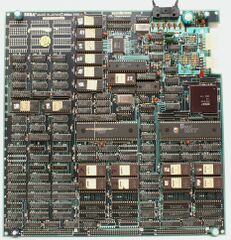
| |||||
| Sega OutRun hardware | |||||
|---|---|---|---|---|---|
| Manufacturer: Sega | |||||
|
Sega's OutRun hardware was released in 1986 with the driving game OutRun. It is a successor to their Hang-On hardware, making it the second in Sega's Super Scaler series of three-dimensional arcade hardware. It was succeeded by the Sega X Board in 1987.
The OutRun hardware, like the Hang-On hardware, has specifications similar to those of the System 16, with the addition of a second 68000 processor and a separate video board which allowed for an extra graphics layer for the road as well as sprite/texture scaling capabilities. The OutRun hardware can do everything the Hang-On hardware can do, but its processors are clocked higher (allowing for quicker calculations), it has more memory, and the video board's capabilities have been expanded, capable of drawing two roads (the Hang-On hardware can only draw one) and rendering sprites/textures using a framebuffer system with a higher fillrate (the Hang-On hardware used a line-buffer system). At the time, the OutRun hardware was a very powerful but expensive arcade board, with arcade operators advised to charge twice as many credits than for regular arcade machines.
Three games made use of the hardware, all of which are driving games. However, only OutRun and Turbo OutRun are truly for this hardware, as Super Hang-On was also released for the Hang-On hardware in a mostly identical form.
Contents
Technical Specifications
- Board composition: CPU Board, Video Board [1]
- Main CPU: 2× 68000 @ 12.5 MHz (16/32‑bit instructions, 4.375 MIPS)
Sound
- Sound CPU: Zilog Z80 @ 4 MHz (8/16‑bit instructions, 0.58 MIPS)
- Sound chips: 2 chips, 24 channels [2]
- FM synthesis chip: Yamaha YM2151 @ 4 MHz (8 FM channels, 8‑bit bus width) [3]
- PCM sampling chip: SegaPCM 315‑5218 Sound Controller @ 4 MHz [1] (stereo output, 16 PCM channels, 12‑bit audio depth,[4] 31.25 kHz sampling rate, 16‑bit bus width)
Graphics
- Video Board GPU: Sega 171‑5377 VIDEO Board graphics chipset @ 25.1748 MHz (5 processors, 88‑bit bus width) [5][1][2]
- Main Board GPU: Sega 171‑5376 CPU Board graphics chipset @ 39.99967 MHz (7 processors, 48‑bit bus width) [5][1][8]
- Video resolution: 320×224 (display), 400×262 (overscan),[1] progressive scan
- Scanlines: 224 (display), 262 (overscan)
- Framebuffer resolution: 512×256 pixels
- Refresh rate: 60.0543 Hz (V‑sync) [1]
- Frame rate: 30–60 frames per second
- Color palette: 98,304
- 16-bit color palette: 15‑bit RGB color depth (32,768 colors), 1‑bit shadow & highlight triples up to 98,304 colors
- Colors on screen: 12,288 [1]
- Graphical planes:
- 2 tilemap layers: System 16B tilemap system, row & column scrolling, parallax scrolling
- 1 text layer
- 1 sprite layer: Hardware sprite-scaling/zooming
- 1 road layer: Can draw 2 roads at once, 512×256 pixels each, tiled bitmaps
- Translucent shadows
- Sprite/texture capabilities: Frame-buffered sprites/textures with zooming capabilities, 128 on‑screen sprites per frame, 7680 sprites/textures scaled per second, 16 colors per sprite/texture
- Video clock cycles: 25.1748 MHz (60.0543 Hz refresh rate)
- Sprite pixel/texel fillrate: 25.1748 million pixels/texels per second,[1] 419,199 pixels/texels per frame/refresh, 1600 sprite pixels/texels per scanline, 128 sprites/textures per scanline
Memory
Gallery
List of Games
- Out Run (1986)
- Super Hang-On (1987)
- Turbo OutRun (1989)
- Limited Edition Hang-On (1991)
References
- ↑ 1.0 1.1 1.2 1.3 1.4 1.5 1.6 1.7 1.8 Sega OutRun Hardware (MAME)
- ↑ 2.0 2.1 http://arcarc.xmission.com/PDF_Arcade_Manuals_and_Schematics/Outrun%20Schematics.pdf#page=8
- ↑ http://map.grauw.nl/resources/sound/yamaha_ym2151_datasheet.pdf
- ↑ Sega X Board Hardware Notes (12/03/2004)
- ↑ 5.0 5.1 Sega 16‑Bit Common Hardware (MAME)
- ↑ 6.0 6.1 File:303A-011A Device List.pdf, page 11
- ↑ 7.0 7.1 File:CK2605 Fusemap.pdf
- ↑ http://arcarc.xmission.com/PDF_Arcade_Manuals_and_Schematics/Outrun%20Schematics.pdf#page=5
- ↑ http://www.datasheets360.com/pdf/-7251416414879408856
- ↑ File:PAL16R datasheet.pdf
- ↑ File:TMM2018 datasheet.pdf
- ↑ File:TurboOutRun Arcade JP Flyer.pdf, page 2
- ↑ Turbo OutRun (MAME)
| Sega arcade boards |
|---|
| Originating in arcades |
|
77
78
79
80
81
82
83
84
85
86
87
88
89
90
91
92
93
94
95
96
97
98
99
|
| Console-based hardware |
|
84
85
86
87
88
89
90
91
92
93
94
95
96
97
98
99
00
01
02
03
04
05
06
07
08
09
10
11
12
13
14
|
| PC-based hardware |
|
05
06
07
08
09
10
11
12
13
14
15
16
17
18
19
20
21
22
23
|
